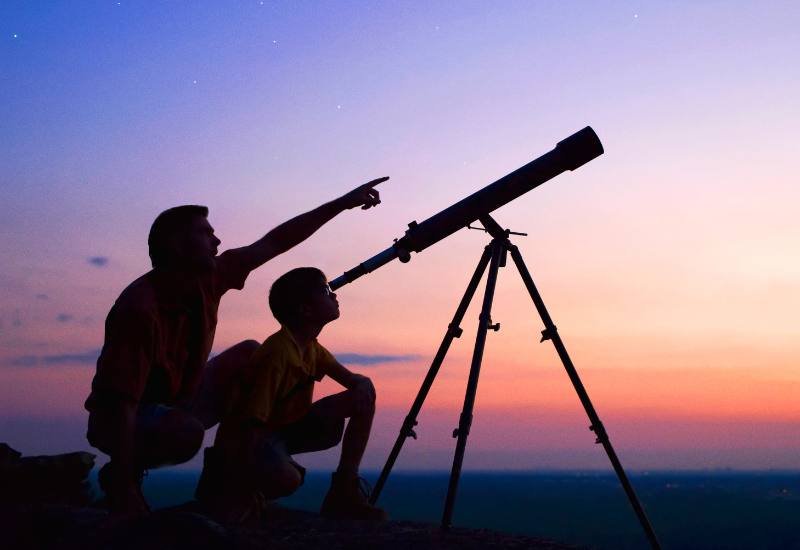Exploring the Cosmos: A Look at Three Iconic Space Telescopes
Vikash Jain
. 3 min read
In order to obtain a more undistorted view of the cosmos, astronomers either put telescopes into orbit around the Earth or send them further away into space. There are a great number of distinct varieties of space telescopes. Some are devoted to the investigation of unique topics, such as the Sun. The various kinds of light that are emitted by objects in space are analyzed by other types of instruments. X-ray and gamma-ray telescopes are used to study the objects in space that are the hottest and most explosive. So, as we marvel at the wonders of space exploration and the discoveries made by space telescopes, let's also appreciate the significant contributions of developers.

Purpose of having Telescopes in Space
1. Hubble Space Telescope
It wasn't until the launch of the Hubble Space Telescope in 1990 that humanity made one of its most significant leaps forward on that journey. The Hubble Space Telescope is an observatory that orbits the Earth. Because it is located above the atmosphere, the view that it provides of the cosmos is typically superior to that provided by telescopes located on the ground.
1.1 - The Hubble Space Telescope (HST) was built in the United States under the supervision of the National Aeronautics and Space Administration (NASA) of the United States after it was authorized for construction in 1977 by the United States Congress. The telescope was named after Edwin Hubble, who was the most prominent American astronomer of the 20th century.
1.2 - The Hubble Space Telescope (HST) is a large reflecting telescope whose mirror optics collect light from heavenly bodies and direct it into two cameras and two spectrographs (which separate radiation into a spectrum and record the spectrum).
1.3 - The wide-field planetary camera is the most important of these instruments. It can take images with either a wide field of view or a high resolution of the planets, as well as images of objects in the galaxy and extragalactic objects.
1.4 - At first, due to the disparity between the cost of the telescope and the results it produced, it was referred to as a "white elephant." Following that, the error was located, and then some optical corrections were carried out with the assistance of advanced image processing techniques.
1.5 - The Space Telescope Science Institute is in charge of providing the ground support for the Hubble Space Telescope's (HST) maintenance as well as its many operations (STScI).
2. Spitzer Space Telescope
The Spitzer Space Telescope is an American satellite that is the fourth and final member of the fleet of "Great Observatories" satellites that are operated by the National Aeronautics and Space Administration. It was given his name in honor of Lyman Spitzer, Jr., an American astrophysicist who, in a seminal paper published in 1946, anticipated the power that could be harnessed by astronomical telescopes that could be operated from space.
2.1 - The Spitzer observatory has been in operation since 2003 and has spent more than 16 years collecting data on the formation, evolution, and constituent parts of planets and other smaller bodies, stars, galaxies, and the overall universe as a whole.
2.2 - It looked at the cosmos using infrared wavelengths to do its research.
2.3 - On August 25, 2003, a Delta II rocket was used to successfully launch the Spitzer space observatory.
2.4 - Telescopes based on Earth would have a difficult time observing this outer ring because it does not reflect a significant amount of visible light. However, Spitzer observed an infrared glow emanating from the ring's cool dust particles.
2.5 - The Spitzer Space Telescope has uncovered potential research foci for NASA's upcoming James Webb Space Telescope, which is scheduled to take flight in 2021.
3. The Herschel Space Observatory's Definitive Legacy
Herschel is the largest observatory that has ever been launched into space, and it was designed to study infrared wavelengths, which belong to a spectrum of light that cannot be seen by the human eye. Data from its nearly four years of observations, from 2009 to 2013, have helped scientists explore a wide variety of topics that are of high interest, including the following topics:
3.1 - Herschel discovered evidence that the Milky Way contains water through his research. The observatory found water in molecular clouds that were in the process of forming stars, identified the delivery of water from interplanetary debris to planets in our solar system.
3.2 - The WHT is capable of observing light in both the visible and infra-red spectrums. With the help of the WHT, the first pieces of evidence for a supermassive black hole at the center of the Milky Way were discovered.
Conclusion
Light-gathering capacity is one of the most important characteristics of a telescope because it determines how well you will be able to see distant stars and objects in the night sky that are very faint. The size of the telescope's aperture is typically responsible for determining the value of this characteristic. When the aperture of the telescope is increased, it is able to collect more light. Magnification A telescope's ability to make distant objects appear significantly larger is referred to as the instrument's magnification.
More Stories from
Exploring the Final Frontier: A Glimpse into the World of Space Research
From probing distant galaxies with space telescopes to charting the potential for human life on other planets, this article provides a glimpse into the evolving field of space research.
Connected Cosmos: Embracing the Future of Space Exploration with Video Chat
Discover the potential for human colonization of other planets, breakthrough propulsion systems, and the expansion of our knowledge of the universe through space-based astronomy.
Chandrayaan-3: India's Ambitious Lunar Mission for Scientific Exploration
Chandrayaan-3, India's third lunar mission led by ISRO, aims to overcome past challenges and demonstrate soft landing capabilities on the Moon.






.png?width=40&aspect_ratio=1:1)


